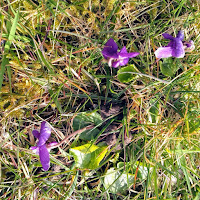It's an interesting phrase, isn't it shrinking violet ? The dictionary defines it as an excessively shy or retiring person. The violet has long had associations with qualities such as faithfulness, chastity, but especially with modesty. Wild violets are dainty plants whose small flowers are often hidden among its leaves and they are frequently inconspicuous among larger plants. It’s no surprise that this self-effacing species should have become linked to the idea of modesty.
The term shrinking violet was first used by the poet, Leigh Hunt, in an article written in 1820, in a magazine called The indicator [Hunt lived in London, the son of American colonists] but the idea of this shy quality also appears in a poem by Wordsworth, written in 1798 – the title is “She dwelt among the untrodden ways” and it is one of his ‘Lucy’ poems
A violet by a mossy stone, half hidden from the eye!
—Fair as a star, when only one is shining in the sky.
 This plant has been popular since classical times because of
its medicinal value and its perfume. A curiosity of the active chemical
constituent of the latter is that after a few seconds it briefly inhibits the
sense of smell. This was very useful in times when hygiene was not so good, and homes, and city streets were smelly places!
This plant has been popular since classical times because of
its medicinal value and its perfume. A curiosity of the active chemical
constituent of the latter is that after a few seconds it briefly inhibits the
sense of smell. This was very useful in times when hygiene was not so good, and homes, and city streets were smelly places!
Violets were added to the rushes on the floors to sweeten rooms and posies were carried by ladies, or pinned to gentlemen’s lapels to block out the stink of the streets. At the start of the 20th Century, violets were the third most important commercially grown flower, after carnations and roses.
George Bernard Shaw, in his play "Pygmalion" made his heroine, Eliza Doolittle, a London Street Seller. She walked through the theatre crowds round Covent Garden calling out to sell her "Violets! Sweet Violets!" Such women earned pennies, despite working long hours, walking in all weathers trying to persuade the wealthy passers by to buy fragrant, delicate blooms. In contrast, the women themselves were cold, and damp and dirty. When the play was made into a musical, one of the most popular songs is set in Covent Garden, when Eliza sings of her hopes and dreams of a better life, somewhere Loverly.
I do hope the shrinking violets at the end of my road flourish - I understand these plants are often self-seeded, and have vigorous underground runners, so they stand a good chance of thriving. I think that would be really loverly!



They do have a propensity to self-seed and so canspring up in unexpected places. One of my favourite poets, John Clare, wrote a poem To the Violets (just his sort of topic). Here is the first verse:-
ReplyDeleteSweet tiny flower of darkly hue,
Lone dweller in the pathless shade;
How much I love thy pensive blue
Of innocence so well display'd!
I shall have to look that one up Philip - I am not at all surprised that you are a John Clare fan!
DeleteI saw some the other day on my long walk. Hope all is well with you.
ReplyDeleteAll good, Packing continues. 24 days...
DeleteOh, I do hope they continue to grow and thrive there! Maybe, in years to come, there will be a carpet of violets in that grassy area to delight all those who pass by!
ReplyDeleteIt's always puzzled me that violets are hardly big enough to make into a bunch to sell - perhaps they were bigger back then
ReplyDeleteApparently there are two
Deletemain varieties - sweet violets, and Parma Violets [did you have the tubes of PV sweets in your childhood?] Queen Victories was very fond of them, and both types are on display in the gardens at her home, Osborne House, on the Isle of Wight.
I love the Lucy poems, such a sad story. I do just love Wordsworth though.
ReplyDelete